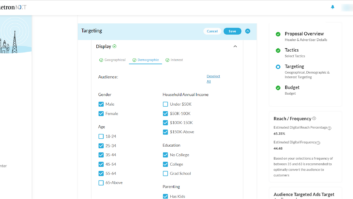
credit: iStockphoto/MorePixels I’m a big fan of the “Back to the Future” movies. There’s a scene in the first one in which Doc Brown works out his elaborate scheme to get Marty back to 1985. He’ll time the acceleration of the DeLorean to a bolt of lightning that he knows will hit the town clocktower at exactly 10:04 p.m. on that very night.
As an old transmitter engineer, I always key in on the part where Marty sets up to race down the street to hit the wire that will zap the flux capacitor. The alarm clock goes off, he jams the car in gear and … it dies.
Marty, I always think, needs a backup ride!
Of course, he finally (and miraculously) starts the car by headbutting the steering wheel; but that’s in the movies. In real life, he’d still be sitting in that dead DeLorean in 1955 with a sore forehead.
Protect thyself
Even if they’re not needed in the movies, there is no question that backup systems are valuable for 24/7 businesses like radio stations.
But the real question is, how valuable? Most engineers that I know would welcome two (or three) of everything. Total redundancy. All studio equipment, STLs, transmitters, antennas, even towers and buildings. Double me up, thank you. But does this make economic sense? Maybe not, but in that case, is there an alternate plan that will afford a reasonable amount of protection without breaking the bank? To find out, you need to do some homework.
A good place to begin is by making a list of critical path points. As it turns out, these are numerous, and sometimes not obvious.
Start with program origination, and draw out everything, from announcer mic all the way through the STL antenna.
When you are done, take a look at your work and play a little mental “what if” game. I promise, you will be shocked. If your list is accurate, showing all line amps, distribution amps, patches, network routers, etc., you will find dozens of unique pieces of equipment and wiring paths that can take you off the air. The trick is to figure out how to quickly circumvent those things if (make that, when) they fail. If that means buying a backup, so be it. But many times, you needn’t go that far.
The simplest and most cost-effective way to buy redundancy is to use what is already in place. If your station has two studios, is there a procedure for getting the second on the air quickly? Just as importantly, does everyone know how to do that? If the answer to either question is “no,” you can start there. Keep in mind that the “standby” studio does not need to be a mirror image of the main. Automation and phone line interfaces, for example, might be ignored, because we are talking about emergency operations here. The goal is to keep the programming (and money) flowing. If some normal production values are missing in the process, that might be an acceptable compromise. Beware of “gotchas” though: issues like console levels, pads, processing, monitor muting and the like can make a quick patch from production to air painful on the ears, unless you know in advance what to expect.
Consider also “outside the box” solutions. An STL failure might be overcome by using a POTS codec for a day. In an extreme emergency, a remote van might be pulled up to the transmitter building and wired right into the processor. We lost the automation system at my station when the computer power supply failed and took the sound card with it. Our operations manager loaded up all of the spots needed for the day (backed up, thankfully) onto a second desktop that appeared on the production console and we aired everything off the WinAmp sound player, through the production console, patched to the air chain. Clunky, for sure, but we aired every spot and saved all the money, which is the point, right?
Stand by …
Transmitter site redundancy presents a totally different set of issues, but is still a balance between cost and benefit.
In major markets, spot rates and audience numbers are so high that most stations are more or less forced to have full redundancy. For the small- or medium-market guy, though, this whole idea of transmitter site backups is complicated, since some of these components are quite pricey. If you own your tower, a spare antenna and line is a nice security blanket in which you can wrap yourself on stormy nights. It is true that total antenna failures are rare, and impending line failures often show up in abnormal VSWR readings, but a spare antenna and line can be helpful in troubleshooting difficult RF problems.
(A word of regulatory caution here: Standby antennas and transmitters must be capable of providing a signal to your community of license, and must be licensed as an auxiliary facility. It’s a simple filing process, but necessary to stay legal when you use them.)
Also, remember that a standby antenna increases your engineering workload, since it must be pressurized and checked periodically. This is true for almost any backup system, and is part of the calculation you should make before plunging headlong into a “Two of Everything” mode.
Standby transmitters provide similar benefits to backup antennas. It is a marvelous thing to be poking around in the 10 kV power supply at 11 a.m. when you are well rested, rather than at 4 a.m. when you have caffeine jitters on two hours sleep. Piece of cake if you have a standby transmitter. Unlikely without one, but again, a second transmitter comes with added cost and maintenance time built right in.
Cost considerations
All decisions regarding backup equipment and systems boil down to one thing: How important is it for your station to be on the air?
Of course it’s important, but how important? Would you pay $10,000 to avoid being off the air for one minute? (Don’t laugh: I visited a UHF television station once that had a full power 60 kilowatt transmitter on an UPS battery backup! The batteries — racks and racks and racks full of them — would keep the rig going until the generator kicked in, so the chief got his no-fail standby, but the costs, in both initial price and upkeep, were enormous.)
While most of us would politely decline the offer to spend $10K per minute for uninterrupted performance, at some point, the cost curve and your personal benefit curve for avoiding an extended outage will cross, and at that point, a backup system makes sense.
Bear in mind that your calculation will be, at best, an educated guess. Antenna failures, for example, are almost always catastrophic, and without a standby, there will be no quick fix. Transmitter failures, on the other hand, can go from minor (a tripped circuit breaker), to epic (smoke roiling out from the 10,000 volt Cabinet O’ Death). It is for the second event that we consider backup rigs.
Finally, backup systems are only as valuable as they are reliable.
I once worked at a major-market NBC TV station with two STLs, running in hot/standby mode with an auto switchover —100 percent STL redundancy. Unfortunately, though, at some point the backup STL had failed, and no one had ever checked the status of the system.
When the day finally arrived that the main failed, the system performed perfectly, switching to the standby, which was stone-cold dead. (As it turned out, that was very nearly the professional fate of the maintenance engineer whose responsibility it was to check those things — me.) Lesson learned: The only way to make sure backups operate as planned is to invest the time and money to test them routinely.
Radio stations are complicated businesses. There is a whole host of technology subject to unplanned failures. Formulating a plan for backing up critical pieces of equipment and systems in a cost-effective manner, well in advance of actually needing it, will help ensure that you never end up in your very own version of a dead DeLorean, watching the clocktower tick down to 10:04.
Jim Withers owns KYRK(FM) in Corpus Christi, Texas. A broadcaster since 1965, he has worked at and managed radio and TV stations in Missouri, Illinois, Texas and Nevada, and built and owned several AMs and FMs in Texas and Wyoming.












